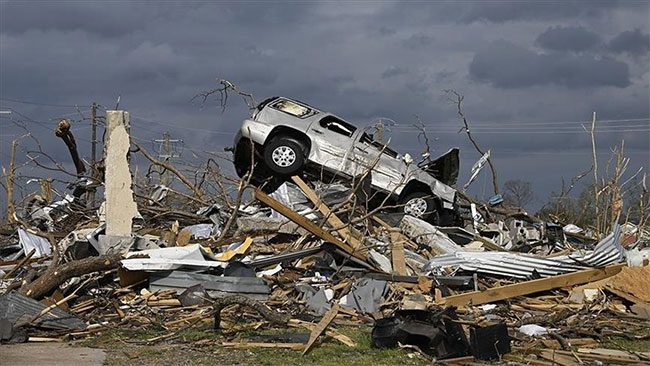The United States is the country most affected by extreme weather phenomena on Earth, ranging from “snowbombs,” tornadoes, floods, atmospheric rivers, to droughts, wildfires, dust storms, and terrifying thunderstorms.
Some experts suggest that the geographical position and diverse terrain of the United States make it susceptible to frequent extreme weather patterns, causing more severe damage compared to other places around the world.

Devastation after a tornado in Arkansas, USA, on April 1, 2023. (Photo: AA/TTXVN).
The fact that the United States is surrounded by two oceans, namely the Pacific and the Atlantic, along with the Gulf of Mexico, the Rocky Mountains, and protruding peninsulas like Florida, facilitates the collision of storms, creating swirling winds that lead to extreme weather events.
The Director of the National Oceanic and Atmospheric Administration (NOAA), Rick Spinrad; climate scientist Kathie Dello; and other experts note that while nature causes many extreme weather phenomena in the U.S., human actions also contribute to worsening natural disasters, compounded by the effects of climate change.
Moreover, colliding air masses result in the country experiencing many severe natural disasters. To date, the U.S. is considered the leader in experiencing tornadoes and severe storms.
A series of tornadoes that struck densely populated refugee areas in Kentucky in December 2021, resulting in nearly 100 fatalities, exemplifies the characteristic phenomenon in the U.S.
Professor of meteorology Walker Ashley from Northern Illinois stated that the colder Arctic air and warmer tropical air create one of the most interesting weather patterns due to the temperature clash between air currents.
Professor Marshall Shepherd, a meteorologist at the University of Georgia and former President of the American Meteorological Society, stated that if extreme weather phenomena impact the entire U.S., then the Southern region is the most severely affected.
All forms of severe weather literally attack this area, including blizzards, tornadoes, floods, thunderstorms, and wildfires…
Professor Ashley commented that the Southern U.S. has more mobile homes compared to other regions in the country. These types of homes are more vulnerable to all dangerous weather phenomena.
Additionally, the damage here is often significant because storms primarily occur at night, when residents may struggle to respond promptly, find safe shelter, and could miss storm warnings while asleep.
According to Professor Ashley, the extreme weather due to the geographical and diverse terrain of the U.S. creates many dangers, but human actions exacerbate these dangers into disasters.
Professor Susan Cutter, Director of the Institute for Resilience Research at the University of South Carolina, believes that one of the measures to help communities withstand extreme weather phenomena is to not develop in ways that easily lead to risks.
The attempt to build and develop barrier islands, especially along the East Coast and Gulf Coast, despite knowing that sand and storms will inevitably come with a certain frequency, “seems to result in a massive waste of budget.”
According to Professor Ashley, the standards for building storm barriers tend to be minimal, and such structures are less likely to withstand natural disasters.
Similarly, Professor Shepherd assesses that the current deteriorating infrastructure in the U.S. is nearly incapable of withstanding natural disaster events.
Furthermore, poverty makes preparation and recovery efforts after natural disasters more challenging, particularly in the Southern region.


















































